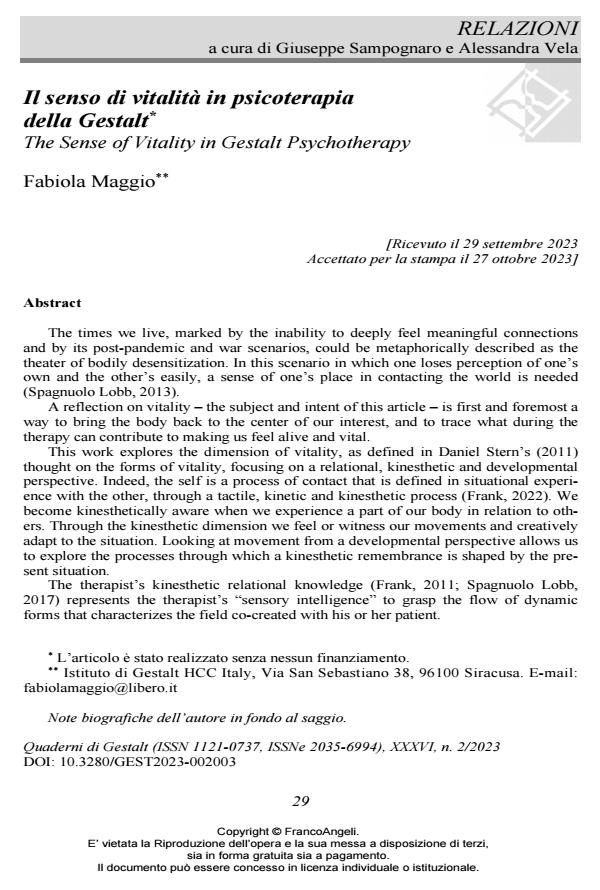The Sense of Vitality in Gestalt Psychotherapy
Journal title QUADERNI DI GESTALT
Author/s Fabiola Maggio
Publishing Year 2024 Issue 2023/2
Language Italian Pages 21 P. 29-49 File size 250 KB
DOI 10.3280/GEST2023-002003
DOI is like a bar code for intellectual property: to have more infomation
click here
Below, you can see the article first page
If you want to buy this article in PDF format, you can do it, following the instructions to buy download credits

FrancoAngeli is member of Publishers International Linking Association, Inc (PILA), a not-for-profit association which run the CrossRef service enabling links to and from online scholarly content.
The times we live, marked by the inability to deeply feel meaningful connections and by its post-pandemic and war scenarios, could be metaphorically described as the theater of bodily desensitization. In this scenario in which one loses perception of one’s own and the other’s easily, a sense of one’s place in contacting the world is needed (Spagnuolo Lobb, 2013). A reflection on vitality – the subject and intent of this article – is first and fore-most a way to bring the body back to the center of our interest, and to trace what dur-ing the therapy can contribute to making us feel alive and vital. This work explores the dimension of vitality, as defined in Daniel Stern’s (2011) thought on the forms of vitality, focusing on a relational, kinesthetic and develop-mental perspective. Indeed, the self is a process of contact that is defined in situa-tional experience with the other, through a tactile, kinetic and kinesthetic process (Frank, 2022). We become kinesthetically aware when we experience a part of our body in relation to others. Through the kinesthetic dimension we feel or witness our movements and creatively adapt to the situation. Looking at movement from a de-velopmental perspective allows us to explore the processes through which a kines-thetic remembrance is shaped by the present situation. The therapist’s kinesthetic relational knowledge (Frank, 2011; Spagnuolo Lobb, 2017) represents the therapist’s “sensory intelligence” to grasp the flow of dynamic forms that characterizes the field co-created with his or her patient. The relational perspective thus emphasizes spontaneous therapeutic action (Spagnuolo Lobb, 2011), aimed at revitalizing the self and cultivating a sense of hope. Hope is that vital, spontaneous, transformative energy that a therapist must be able to discern and sustain (Perls et al., 1997; Spagnuolo Lobb, 2014).
Keywords: Forms of Vitality, movement, kinaesthetic resonance, Aesthetic Relational Knowleadge.
- Una lettura gestaltica dei disturbi psicosomatici: "la pelle che brucia" Michele Cannavò, Dario Davì, Brenda Cervellione, in QUADERNI DI GESTALT 2/2024 pp.33
DOI: 10.3280/qg2024-2oa18163
Fabiola Maggio, Il senso di vitalità in psicoterapia della Gestalt in "QUADERNI DI GESTALT" 2/2023, pp 29-49, DOI: 10.3280/GEST2023-002003